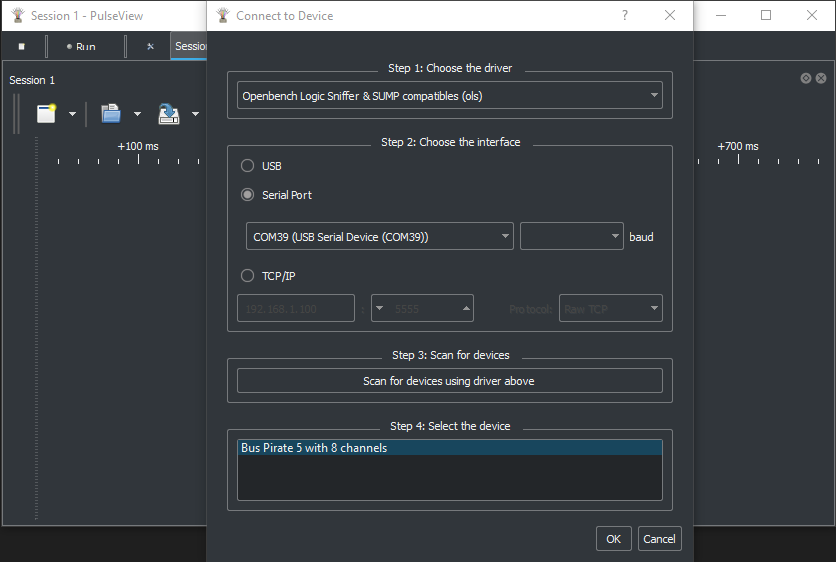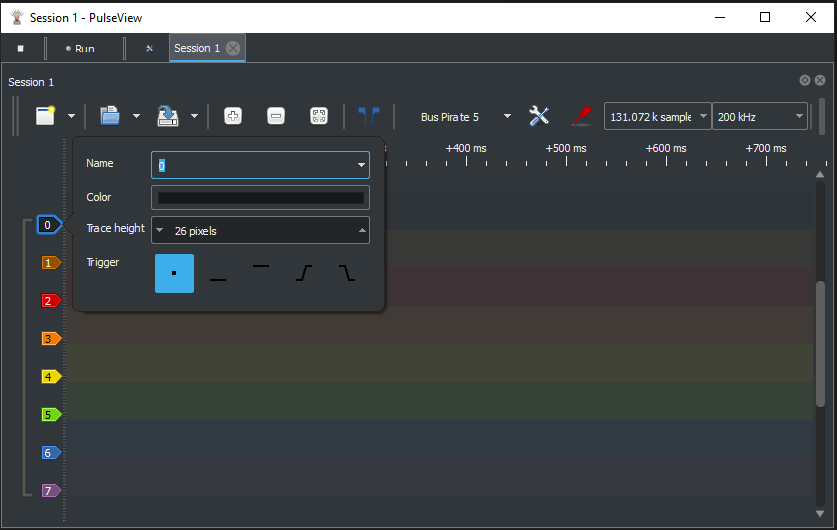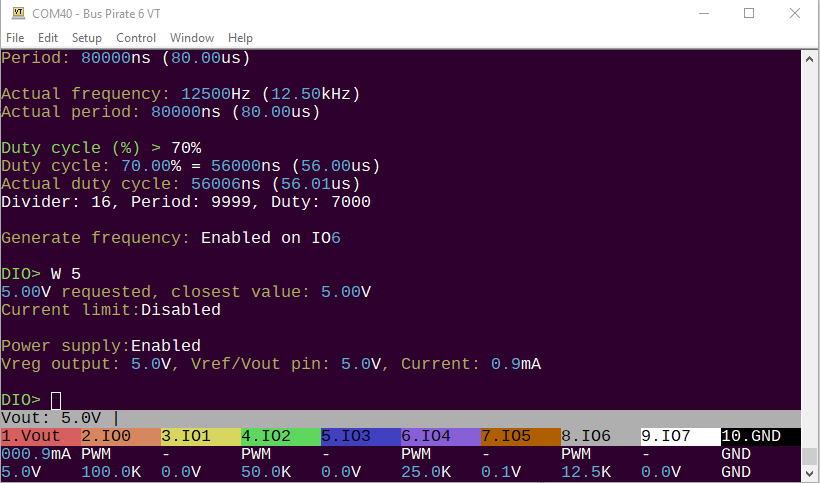PulseView with SUMP interface
See the latest version. This site is no longer maintained.
See the latest version for up-to-date documentation. Docs have been completely reworked and moved to a new location. The new site is more user-friendly and searchable. It's also easier for the developers to work with.

Sigrok/PulseView is a popular open source logic analyzer GUI that runs on Windows, Linux, and Mac. The Bus Pirate supports Sigrok/PulseView through a SUMP protocol interface.
The Bus Pirate can be used as a logic analyzer in multiple ways. This page documents the SUMP compatible interface.
- Jawi OLS Client (Needs to be re-packaged for modern operating systems)
Other software also supports the SUMP protocol, but many haven't been updated in years and don't operate on modern operating systems.
Capabilities
- 62.5MSPS (or more if overclocked)
- 131K samples
- 8 channels
- Trigger: single pin, high or low
- Base pin can be set to an internal pin for debugging the Bus Pirate itself
Bus Pirate Setup
Configure the Bus Pirate for SUMP logic analyzer mode.
Change to HiZ mode
Mode: HiZ
HiZ>
For general purpose logic analyzer use, change to HiZ mode with the m 1 command. This will make all the pins inputs and disable pull-up resistors.
There is no restriction on using the logic analyzer while the Bus Pirate is not in HiZ mode. However, prior to Bus Pirate hardware 6, all pins are measured behind the IO buffer. This means the logic capture may not match the actual output of the IO buffer on pins configured as outputs. This is not a problem when the Bus Pirate is used as a logic analyzer in HiZ mode and all pins are inputs.
Enable SUMP Interface
Select binary mode
1. SUMP logic analyzer
2. Binmode test framework
3. Arduino CH32V003 SWIO
4. Follow along logic analyzer
x. Exit
> 1
Binmode selected: SUMP logic analyzer
HiZ>
Enable the SUMP binary interface with the binmode command. A SUMP-compatible logic analyzer interface will now respond to the Bus Pirate's second serial port.
Sigrok/PulseView
Download and install Sigrok/PulseView for your operating system. There is currently a bug in the USB drivers used in the official Sigrok/PulseView Windows release. Use the patched version for Windows until a fix is accepted to the official project.
Setup
Open PulseView. From the device drop down select Connect to Device.

- Choose
Openbench Logic Sniffer & SUMP compatables (ols)as the device driver - Choose
Serial Portas the interface and select the Bus Pirate secondary (binmode) serial port from the list - Click
Scan for devices using driver above
The Bus Pirate device should be detected. Click OK to connect.
Power Supply in SUMP mode
The IO buffers need a power supply, or we won't be able to see any signals. A 3.3volt power supply is automatically enabled when the SUMP serial port is opened in the following circumstances:
- If the Bus Pirate terminal is not open
- If the Bus Pirate terminal is open and in HiZ mode The power supply is disabled when the SUMP serial port is closed.
Configure

Select the sampling speed and number of samples to capture using the two drop down menus.
To configure a trigger, click the channel label and choose none, high, or low. The trigger type will be displayed on the graph.
Capture

With or without a trigger, click the run button to start the capture. When complete, the captured data will be displayed in the graph.
Capture During Use

The terminal can be used while the SUMP logic analyzer is running. You can set triggers and capture while sending or receiving data from the Bus Pirate terminal.
To test capture during use:
m 8- Select any mode, we'll use DIO mode because all the pins are freeG- Use theGcommand to start pulse-width modulation output on more or more pinsW 5- Make sure the buffers are powered
All Bus Pirates support logic capture while the hardware is in use, however only Bus Pirate 6 has a second buffer to capture pins directly. In earlier hardware all output pins are captured behind the IO buffer. This means the logic capture may not match the actual output of the IO buffer. This is not a problem when the Bus Pirate is used as a logic analyzer only and all pins are inputs.
Logic Analyzer System
The logic command and the follow along binmode interface can be run at the same time. However, the capture buffer is shared with SUMP logic analyzer mode. SUMP and follow along logic analyzer modes cannot be used at the same time and will result in a memory error warning.